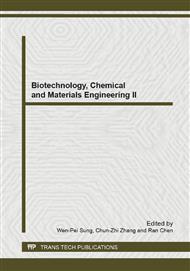p.967
p.971
p.975
p.979
p.984
p.988
p.993
p.997
p.1001
Optimization of Enzymatic Preparation Anti-Oxidation Peptides from Pigskin Gelatin
Abstract:
We screen the neutral protease enzyme used to hydrolysis, through scavenging effect of six enzymatic hydrolysate on O2-•. The hydrolysis of condition was optimized by response surface methodology on the basis of single factor experiments. The optimized condition was as follows: hydrolysis temperature 43.65 °C, pH 6.25, time 3.29h, and content of enzyme 3.0% (W/W). Under this condition, the O2-•scavenging rate of the hydrolyzate was up to 72.01%. The experimental results were 71.15%.
Info:
Periodical:
Pages:
984-987
Citation:
Online since:
January 2013
Authors:
Price:
Сopyright:
© 2013 Trans Tech Publications Ltd. All Rights Reserved
Share:
Citation:


